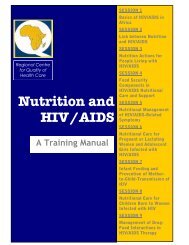Cost and Effective Analysis of the LINKAGES ... - Linkages Project
Cost and Effective Analysis of the LINKAGES ... - Linkages Project
Cost and Effective Analysis of the LINKAGES ... - Linkages Project
You also want an ePaper? Increase the reach of your titles
YUMPU automatically turns print PDFs into web optimized ePapers that Google loves.
activities were implemented. This includes costs for local regional trainings, supervision, <strong>and</strong>advocacy activities. For central-level workshops which involved MCH pr<strong>of</strong>essions from all regions,such as training <strong>of</strong> trainers, costs were allocated based on number <strong>of</strong> participants from each region.<strong>Cost</strong>s <strong>of</strong> activities reaching all <strong>of</strong> <strong>LINKAGES</strong> intervention clinics in all three regions were allocatedbased on <strong>the</strong> number <strong>of</strong> MCH clinics in each region during <strong>the</strong> study period. Such activities includedevelopment <strong>and</strong> production <strong>of</strong> IEC materials, strategic planning activities at <strong>the</strong> Breastfeeding Unit,capacity building <strong>of</strong> master trainers <strong>of</strong> <strong>the</strong> Unit.MOH/MCH costs were allocated in <strong>the</strong> same manner as <strong>LINKAGES</strong> costs.The content <strong>of</strong> each activity was reviewed <strong>and</strong> apportioned based on its specific LAM <strong>and</strong> EBFcontent. For trainings, apportioning an activity to a behavior was based on a review <strong>of</strong> each trainingmodule <strong>and</strong> <strong>the</strong> time spent discussing each topic. <strong>Cost</strong>s <strong>of</strong> IEC materials were allocated based on <strong>the</strong>review <strong>of</strong> <strong>the</strong> content <strong>and</strong> specific messages or materials. For some activities, <strong>the</strong>re was noquantitative basis for apportionment to targeted behavior – for example, routine supervisions by<strong>LINKAGES</strong> <strong>and</strong> MOH/MCH staff. In <strong>the</strong>se cases, <strong>the</strong> costs <strong>of</strong> activities were apportioned evenly toLAM <strong>and</strong> EBF indicators.4.4. Use <strong>of</strong> MOH Logistics Data to Measure OutcomesData to measure outcomes are derived from <strong>the</strong> MOH’s Contraceptive Logistics System data for <strong>the</strong>study period. The Jordan Contraceptive Logistics System project was funded over a three year period(1996-1999) by <strong>the</strong> United States Agency for International Development (USAID) <strong>and</strong> wasimplemented by John Snow Inc. to assist <strong>the</strong> Ministry <strong>of</strong> Health in establishing a new contraceptivelogistics system. The logistics system covers all <strong>of</strong> <strong>the</strong> MOH facilities, Royal Medical Services, <strong>and</strong>NGOs providing family planning services in <strong>the</strong> Kingdom, <strong>and</strong> is now managed centrally by <strong>the</strong>MOH/MCH.Data used in this study are based on MCH family clinic attendance. At <strong>the</strong>se clinics all women whocome for family planning counseling are registered as a new or continuing user <strong>of</strong> a particularmethod; LAM was included in <strong>the</strong> Logistics system beginning January 1999. These clinic-level dataare <strong>the</strong>n sent monthly to <strong>the</strong> MCH where <strong>the</strong>y are input into <strong>the</strong> database. To assure <strong>the</strong> quality <strong>of</strong>data <strong>the</strong> Logistic staff make periodic supervisory visits to <strong>the</strong> clinics.Target population or project beneficiaries include <strong>the</strong> total number <strong>of</strong> antenatal <strong>and</strong> postpartumwomen with children < 6 months served by all MCH clinics during <strong>the</strong> study period. Total number <strong>of</strong>women served by MCH clinics is based on new registered women. The LAM User Rate is calculatedbased on <strong>the</strong> number <strong>of</strong> women choosing LAM as a family planning method out <strong>of</strong> all women <strong>of</strong>reproductive age who use MCH for family planning services.Table 2 shows <strong>the</strong> December’01 baseline <strong>and</strong> December’02 endline data, by region, for each <strong>of</strong> <strong>the</strong>two LAM indicators.10 4. Methodology <strong>LINKAGES</strong> <strong>Project</strong>/AED
















